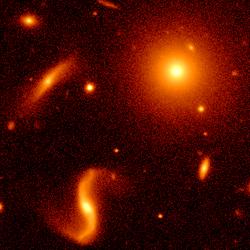

|
Astronomers at Tuorla Observatory and Metsähovi Radio Observatory, have made a study of over 300 so-called "BL Lac" galaxies, concluding that one of the standard explanations for these energetic emittors, which divides BL Lacs into various subtypes, may be flawed. BL Lacs are galaxies which host a black hole at their core. Many, indeed almost all galaxies, are now thought to host central black holes — our own Milky Way galaxy is a good example. Many of these black holes are surrounded by disks of matter, slowly working its way inwards to be swallowed, as well as having one or two bright 'jets', probably aligned perpendicularly to the disk. When one of these jets happens to be pointed pretty much toward us, observing at a safe distance on the Earth, spectacular effects can occur. Firstly, viewing the jet like this makes the central core of the galaxy look extremely bright — as bright as the entire galaxy in which the black hole is located. Secondly, the spectrum of energy emitted can have very marked changes in its character — emissions from the core, normally seen at radio and optical wavelengths, can emerge 'boosted' in energy all the way to the X-ray or gamma ray regions. Now researchers Elina Nieppola, Merja Tornikoski and Esko Valtaoja have collected data for more than 300 BL Lacs, compiling their spectral properties from the radio through optical, infra-red, and if available X-ray and gamma ray regions. A dedicated observational programme at Metsähovi Radio Telescope running from 2001-2004, at 37 GHz, formed the major fraction data collected. The researchers measured the amount of energy emitted by the objects in the form of 'synchrotron' radiation, a result of the boosting provided because we happen to be looking directly down the jet coming from very close to the black hole. A prediction of the model for BL Lacs is that the synchrotron spectral energy distribution should have a peak in energy at a higher wavelength for more energetic (i.e. luminous) sources. The researchers found no such trend. Their sample is for the first time large enough to confirm this quite clearly. Until now, two clear types of BL Lac have been recognised, those which peak in energy emission at high energies, and those at low energies. This distinction, while useful, is emphasised because BL Lacs are most easily detected in two distinct wave bands — by their radio and X-ray emissions. Based on the smooth distribution of many properties of BL Lacs right across the electromagnetic spectrum, the researchers conclude that the "underlying BL Lac population as a whole is continuous and undivided",
Like to a pair of loving turtle-doves King Henry VI, Part I, Act 2, Scene 2.
Related Links |

Image of a BL Lac. The object is RGB1532+302 (the large elliptical galaxy in the upper right corner). The host galaxy of this nearby BL Lac (redshift, z = 0.064) is surrounded by a small group of spiral galaxies. The nucleus is relatively weak, only ~5% of the total light of the system comes from the core. Credit: Kari Nilsson. |